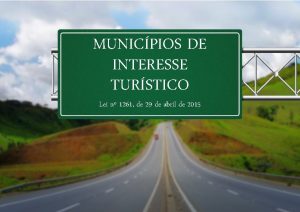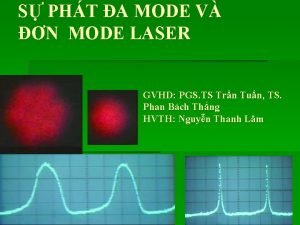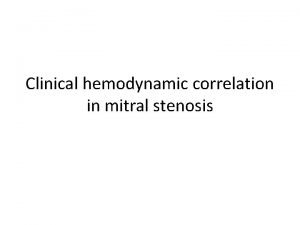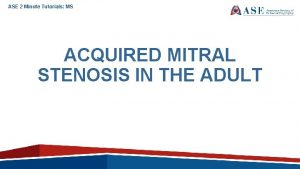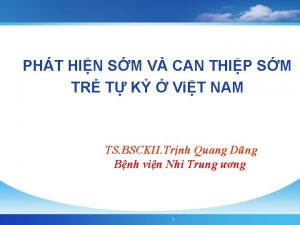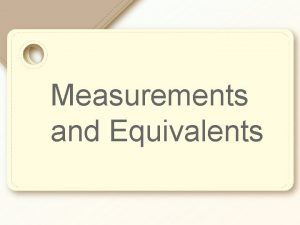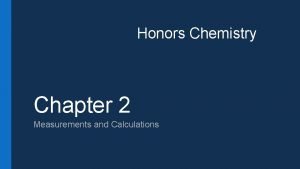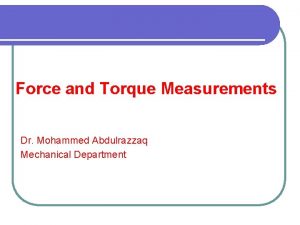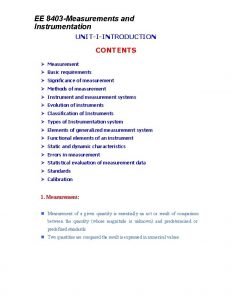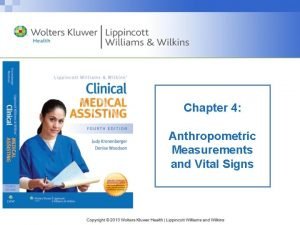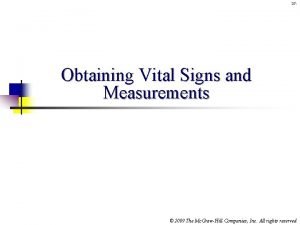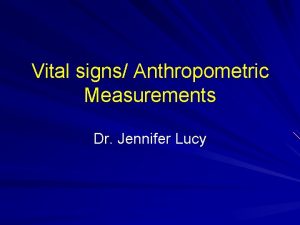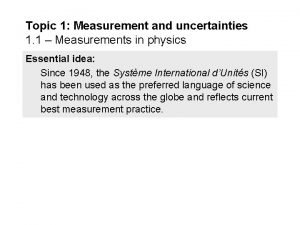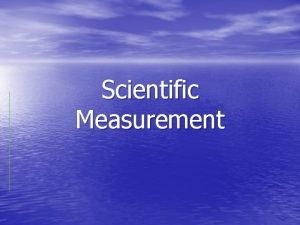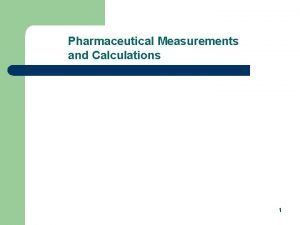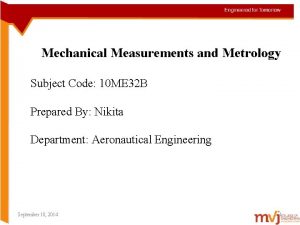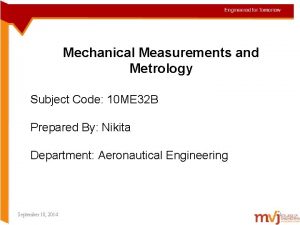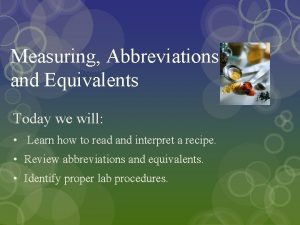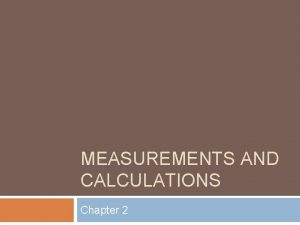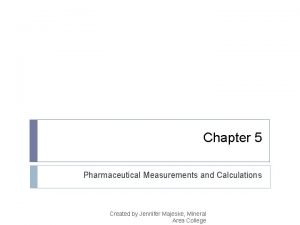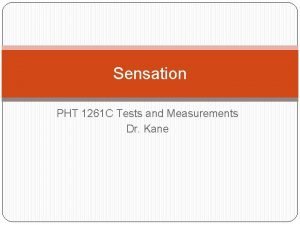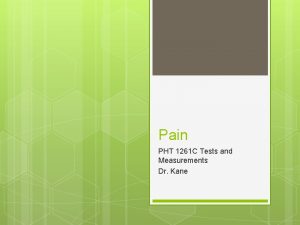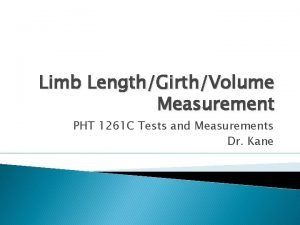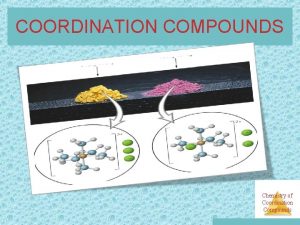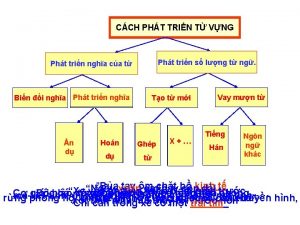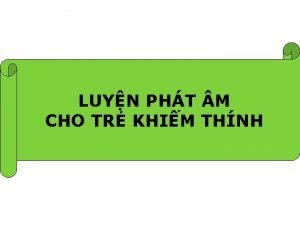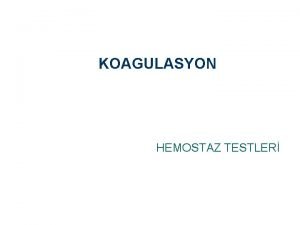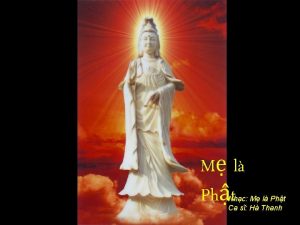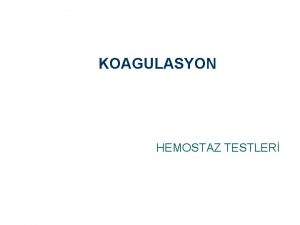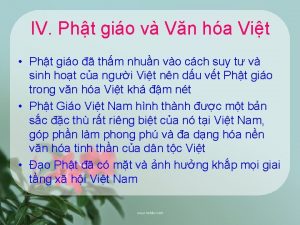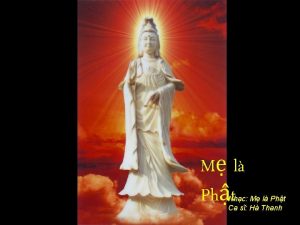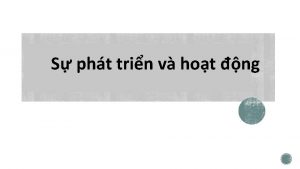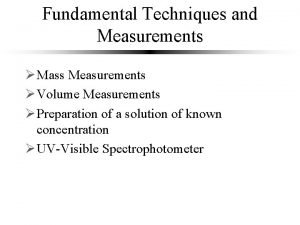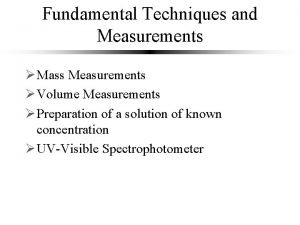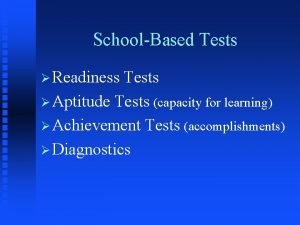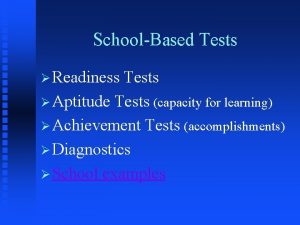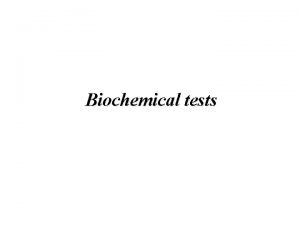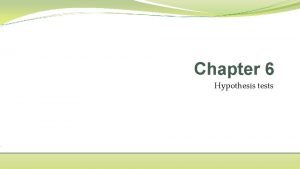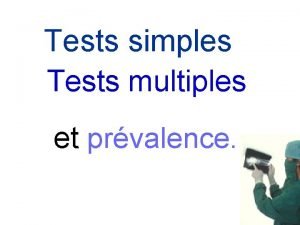Coordination PHT 1261 C Tests and Measurements Dr



























- Slides: 27

Coordination PHT 1261 C Tests and Measurements Dr. Kane

Definitions Motor Control Coordination Dexterity Agility

Types of Coordination Intralimb Interlimb Visual Motor Eye- hand Eye-hand-head

Purposes of Coordination Examination Determine muscle activity characteristics during voluntary movement Determine ability of muscles or groups of muscles to work together to perform a task Determine level of skill & efficiency of movement Determine ability to initiate, control & terminate movement Timing, sequencing, & accuracy of movement patterns Effects of therapeutic & pharmacological intervention on motor function over time

Other Purposes Assists with establishing diagnosis of underlying impairments, functional limitations, & disability. Assists with establishing anticipated goals to remediate impairments Assists with formulating expected outcomes to remediate functional limitations and disability Support decision making in establishing prognosis & determining specific, direct interventions

Motor System Peripheral Element Muscles & joints & sensory & motor innervation Central Element Neocortex and basal ganglia – strategy; goal of movement & strategy to help her win Motor Cortex and cerebellum – tactics; how do we plan out achieving that goal Brain Stem and Spinal cord – execution; carry out movement plan & make adjustments as needed

Motor Cortex Brodmann’s (cortical) area 4 Precentral gyrus; Primary Motor Cortex (PMC) Largest concentration of corticospinal neurons Controls contralateral voluntary movements; single joint motion Brodmann’s (cortical) area 6 Anterior to area 4; Supplementary Motor Area (SMA) – axons that directly innervate motor units involved in initiation of movement, simultaneous B grasping, sequential tasks, orientation of eyes & head Premotor Area (PMA) – input to reticulospinal neurons that innervate motor units that control trunk & proximal limb; anticipatory postural changes; multiple joints; intricate motions

Motor Cortex - continued SMA & PMA arranged like motor homunculus Motor Cortex receives information from: Somatosensory cortex – peripheral receptor fields; via thalamus Cerebellum Basal Ganglia

Descending Motor Pathways Corticospinal (pyramidal) Tracts From Areas 4 & 6 directly to spinal cord Cross to opposite side in medulla Skilled, fine motor control distal limbs Corticobulbar Tract Motor cranial nerves Tectospinal Tract Motor neurons in cervical spinal cord; head motions during visual motor tasks

Descending Motor Pathways (continued) Reticulospinal Tract (medial & lateral) Anterior horn of SC: muscle tone & reflex activity Important influence on posture and gait Vestibulospinal Tract (medial & lateral) Postural control & head movements Coordinated head & eye movements Rubrospinal Tract Merges with corticospinal tract; insignificant function

Cerebellum Regulation of movement, postural control & muscle tone Comparator & error-correcting mechanism Feed forward control; closed loop system

Basal Ganglia Caudate nucleus, putamen, globus pallidus; Also includes subthalamic nucleus and substantia nigra Initiation & regulation of gross intentional movement Planning & execution of complex motor responses Facilitation of desired motor responses (inhibiting others) Ability to accomplish automatic movements & postural adjustments

Dorsal Column Medial Lemniscal Pathway Responsible for afferent transmission of discriminatory sensations Discriminative touch, stereognosis, tactile pressure, barognosis, graphesthesia, texture recognition, kinesthesia, 2 point discrimination, proprioception, vibration

Coordination Impairments – Cerebellar Pathology See table 7. 1 page 200 Ataxia Dysarthria (scanning speech) Dysdiadochokinesia Dysmetria (hyper or hypometria) Dyssynergia (movement decomposition) Asynergia Gait Ataxia Hypotonia Nystagmus Rebound Phenomenon Tremor Intention/kinetic Postural/static Titubation Delayed reaction time Difficulty in changing force, speed, or direction of movement

Basal Ganglia Pathology Poverty & slowness of movement Involuntary extraneous movement Alterations in muscle tone and posture Akinesia – freezing Athetosis – distal UE Bradykinesia Chorea – UE Choreoathetosis Dystonia Hemiballismus Hyperkinesis/hypokinesis Rigidity Lead pipe Cogwheel Resting tremors

Dorsal Column Medial Lemniscal Pathology Less characteristic Lack of joint position sense Lack of awareness of movement Impaired localized touch sensation Gait abnormalities Dysmetria Decreased fine motor skills Positive Romberg's sign

Screenings Prior to Coordination Exam Purpose: Determine need for further/more detailed exam Rule out or differentiate specific system involvement Determine need for referral to another health care professional Focus search for origin of symptoms to a specific body part Identify system related impairments that contribute to functional limitations or disability Determine which specific tests & measurements are needed for examination

Screening ROM –active; grossly functional; WFL; WNL Strength – not specific testing positions Sensation – superficial, deep, combined

Coordination Tests Gross Motor Movements Posture, balance, large muscle extremity movements Crawling, kneeling, standing, walking, running Fine Motor Movements Small muscle groups that involve skillful controlled manipulation of objects Finger dexterity – buttons, typing, handwriting

Coordination Tests - continued Nonequilibrium tests Static and mobile components of movement while sitting (gross and fine motor) Equilibrium Tests (balance or postural stability) Static and dynamic components of posture and balance in standing (primarily gross motor)

Motor Task Requirements Mobility Stability (static postural control) Controlled Mobility (dynamic postural control) Static dynamic control Skill

Areas of Movement Capabilities Alternate or reciprocal motion Movement composition (synergy) Movement accuracy Fixation or limb holding Equilibrium (postural stability)

Preparation for Coordination Exam Testing Environment Patient Preparation Preliminary Observation Gait Analysis (or observation)

Coordination Examination Non-Equilibrium Tests – see Table 7. 3 page 212 16 tests Equilibrium Tests – see Box 7. 3 page 213. 24 tests

Basic Balance Tests Double limb stance Single Limb Stance Tandem Stance Romberg test Sit to stand (STS) Sit Down (SIT) Reaching Movements Turning Step ups Walking – with turns, timed, with head motions, stop/start

Grading Basic Balance Tests See Table 8. 9 page 254 O’Sullivan Normal Good Fair Poor

Standardized Balance Testing (O’Sullivan pp. 254 -259) Berg Balance Test Tinetti POMA Timed up and Go (TUG)/Get up and GO (GUG) Romberg Test Functional Reach Test/ Multidirectional Reach Test Timed Walking Test Balance Efficacy Scale (BES)
 Lei.1261
Lei.1261 Ace different tests help iq still
Ace different tests help iq still Non equilibrium test for coordination ppt
Non equilibrium test for coordination ppt Slidetodoc. com
Slidetodoc. com Logo pht
Logo pht S'pht
S'pht Pht mitral valve
Pht mitral valve Pressure half time formula
Pressure half time formula Giá pht
Giá pht Giá pht
Giá pht Measurements equivalents and adjustments
Measurements equivalents and adjustments Chapter 2 measurements and calculations
Chapter 2 measurements and calculations Force and torque measurements
Force and torque measurements Ee8403 measurements and instrumentation
Ee8403 measurements and instrumentation Vital signs and anthropometric measurements
Vital signs and anthropometric measurements Vital signs and measurements chapter 37
Vital signs and measurements chapter 37 Segment lengths in circles formulas
Segment lengths in circles formulas Orthostatic vital signs
Orthostatic vital signs Dr lucy jennifer
Dr lucy jennifer Measurements and uncertainties ib physics
Measurements and uncertainties ib physics Measurements and their uncertainty answer key
Measurements and their uncertainty answer key Pharmaceutical measurements
Pharmaceutical measurements Metrology and measurements subject code
Metrology and measurements subject code Metrology and measurements subject code
Metrology and measurements subject code Abbreviation for tablespoon
Abbreviation for tablespoon Percent error example
Percent error example Household measurements in pharmacy
Household measurements in pharmacy Si unit of pressure
Si unit of pressure
